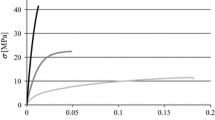Abstract
Characterizing the fracture energy of bonded adhesive joints over a range of mode mixities often requires special fixtures or a variety of test configurations. By pairing a tapered and a constant thickness adherend, a hybrid double cantilever beam (DCB) specimen is proposed. This asymmetric tapered DCB configuration can be used to determine the fracture energy as a function of mode mixity. As the debond propagates, the relative stiffness of the adherends varies in a systematic manner, resulting in a range of mode mixities from 0° to approximately 20°. Strain energy release rates were obtained using corrected beam theory and a finite element fracture analysis. Single-leg bending tests were used to determine the fracture energy at mode mixity up to 56°. Constant thickness and tapered DCB tests were used to determine the mode I fracture energy. The resulting fracture envelope was constructed in order to show the dependence of the fracture energy on mode mixity for a two part acrylic adhesive.
Similar content being viewed by others
References
ASTM-D412-98a (1998) Standard test methods for vulcanized rubber and thermoplastic rubbers and thermoplastic elastomers-tension. Annual book of ASTM standards. West Conshohocken, ASTM
ASTM-D3433-99 (2001) Standard test method for fracture strength in cleavage of adhesives in bonded metal joints. Annual book of ASTM standards. West Conshohocken, ASTM 15.06:225–231
Blackman B, Dear JP et al (1991) The calculation of adhesive fracture energies from double-cantilever beam test specimens. J Mater Sci Lett 10(5): 253–256
Blackman BRK, Hadavinia H et al (2003) The calculation of adhesive fracture energies in mode I: revisiting the tapered double cantilever beam (TDCB) test. Eng Fract Mech 70(2): 233–248
Chen B, Dillard DA (2002) Crack path selection in adhesively bonded joints. In: Dillard DA, Pocius AV (eds) Adhesion science and engineering-I: the mechanics of adhesion. Elsevier Science, Amsterdam
Chen B, Dillard DA et al (2002) Crack path selection in adhesively bonded joints: the roles of external loads and specimen geometry. Int J Fract 114(2): 167–190
Davidson BD, Sundararaman V (1996) A single leg bending test for interfacial fracture toughness determination. Int J Fract 78(2): 193–210
Fleck NA, Hutchinson JW et al (1991) Crack path selection in a brittle adhesive layer. Int J Solids Struct 27(13): 1683–1703
Hutchinson JW, Suo Z (1992) Mixed-mode cracking in layered materials. Adv Appl Mech 29: 63–191
Kanninen MF (1973) An augmented double cantilever beam model for studying crack propagation and arrest. Int J Fract 9: 83–92
Liang YM, Liechti KM (1995) Toughening mechanisms in mixed-mode interfacial fracture. Int J Solids Struct 32(6–7): 957–978
Liechti KM, Chai YS (1992) Asymmetric shielding in interfacial fracture under inplane shear. J Appl Mech-Trans ASME 59(2): 295–304
Parvatareddy H, Dillard DA (1999) Effect of mode-mixity on the fracture toughness of Ti-6Al-4V/FM-5 adhesive joints. Int J Fract 96(3): 215–228
Pohlit DJ, Dillard DA et al Mixed mode dynamic fracture testing of bonded composite beams. J Adhes Adhes, in preparation
Russel AJ, Street KN (1985) Moisture and temperature effects on the mixed mond delamination fracture of unidirectional graphite/epoxy. In: Johnson WS (eds) STP 876 delamination and debonding of materials. ASTM, Philadelphia, pp 349–370
Singh HK, Chakraborty A et al Mixed mode fracture testing of adhesively-bonded wood using a novel dual actuator load frame. Wood Fiber Sci, in review
Sundararaman V, Davidson BD (1997) An unsymmetric double cantilever beam test for interfacial fracture toughness determination. Int J Solids Struct 34(7): 799–817
Thouless MD (1990) Fracture of a model interface under mixed-mode loading. Acta Metallurgica Et Materialia 38(6): 1135–1140
Williams JG (1993) A review of the determination of energy-release rates for strips in tension and bending. 1. Static solutions. J Strain Anal Eng Des 28(4): 237–246
Author information
Authors and Affiliations
Corresponding author
Rights and permissions
About this article
Cite this article
Park, S., Dillard, D.A. Development of a simple mixed-mode fracture test and the resulting fracture energy envelope for an adhesive bond. Int J Fract 148, 261–271 (2007). https://doi.org/10.1007/s10704-008-9200-z
Received:
Accepted:
Published:
Issue Date:
DOI: https://doi.org/10.1007/s10704-008-9200-z




